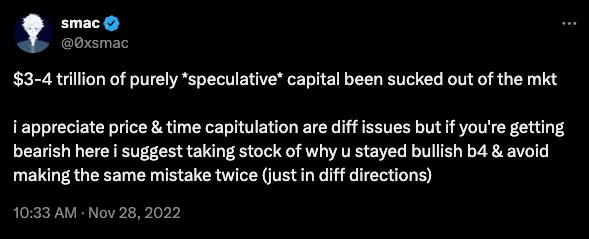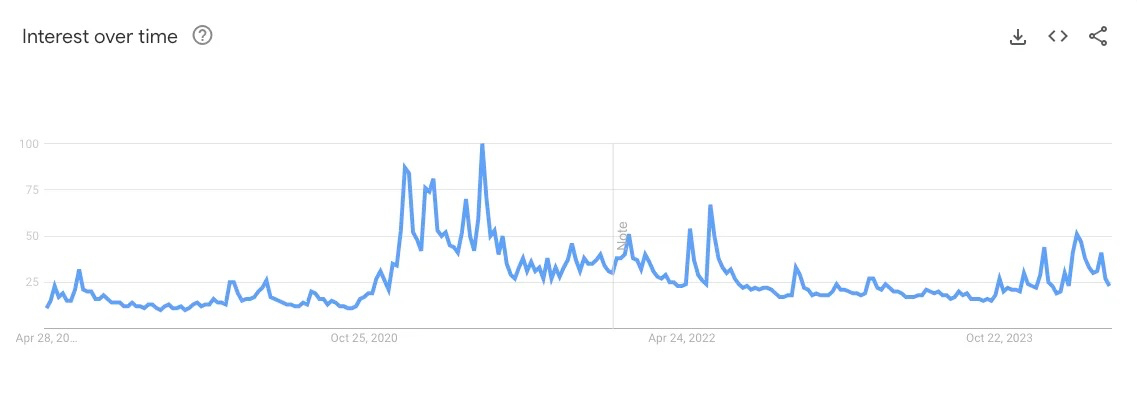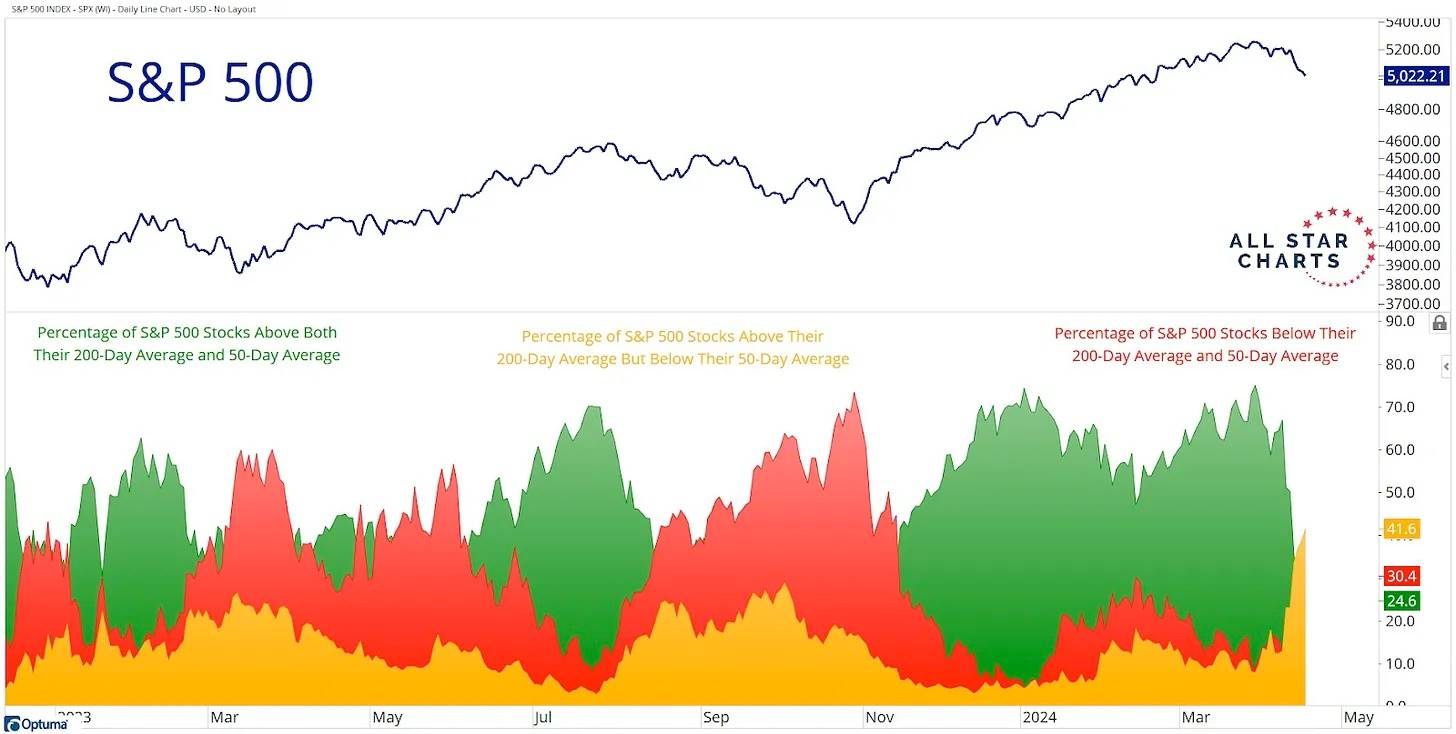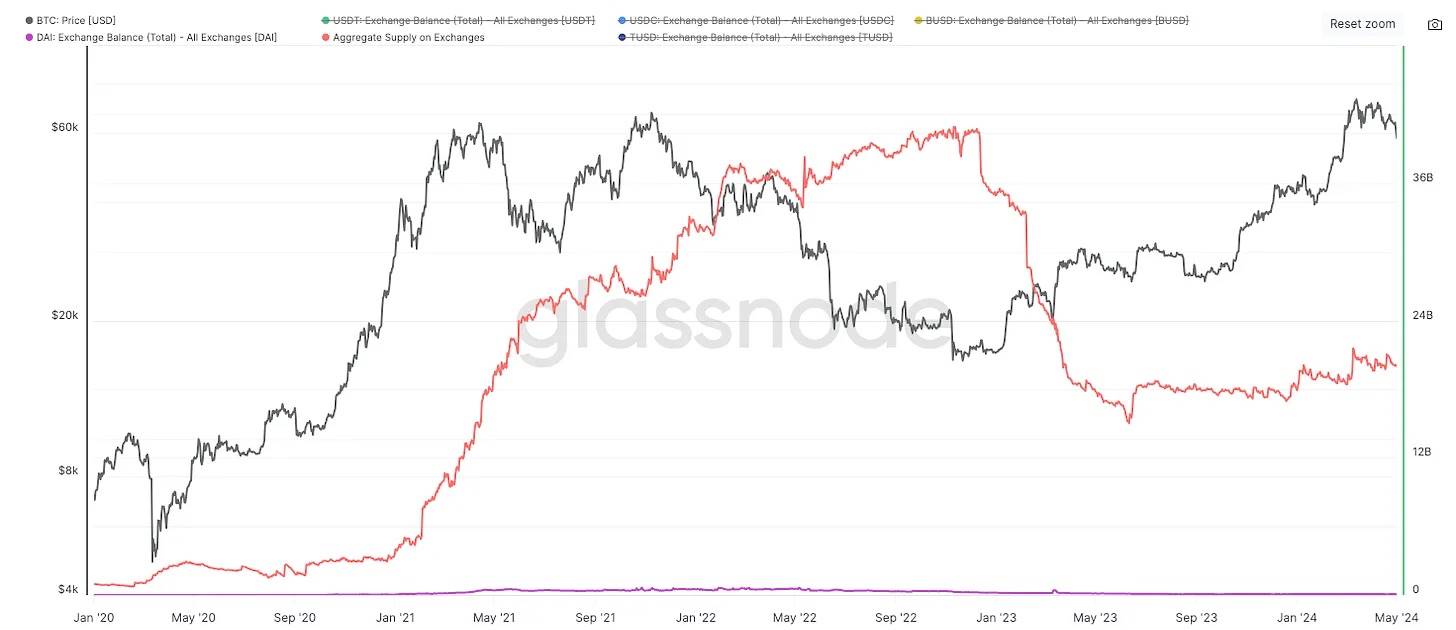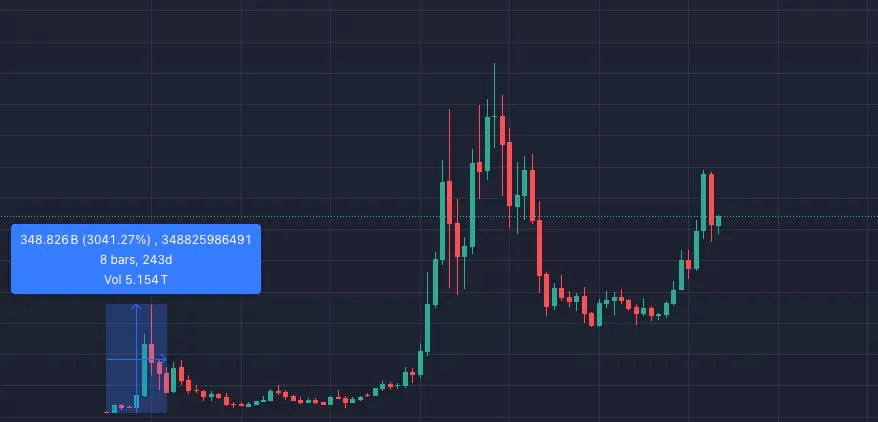Crypto market cycle discussion: Where are we in this cycle?
Original author: 0x smac
Original translation: TechFlow
Introduction
The author of this article, 0x smac, delves into the cyclical position of the current crypto market and questions the effectiveness of group wisdom in financial market decision-making. The article reviews market changes since the FTX crash in 2022 and predicts future market trends by comparing the price trends of Bitcoin and Ethereum. In addition, the author also discusses the potential impact of ETF approval, institutional capital inflows, and changes in the structure of the cryptocurrency market on the market, providing a perspective for a deep understanding of the crypto market.
Text content
I tend to think that the wisdom of crowds is mostly a joke. Sure, there are things where the wisdom of crowds is important, but there are too many examples of humans behaving irrationally (especially when it comes to money) or not understanding the cognitive biases they experience. More specifically, Im referring to crowds that have a tendency to be overconfident/irrational.
For example, financial market participants.
I was curious what people thought about a possible “soft landing” after the FTX crash in November 2022 and QQQ falling ~30% from its all-time high. Needless to say, only 1 in 5 people were fairly certain we would achieve it.
A year later, with Bitcoin having doubled in price (to around $35,000) and in an undeniable uptrend, I was once again curious about how people felt. Typically I use polls like this to assess positioning. It’s just one data point, but I’ve found that most people answer what they hope will happen — especially on Twitter. So it’s not surprising that only half of people think a price increase of about 30% is more likely than a 20% drop.
Even fewer expect prices to continue rising.
For many reasons, I was pretty confident that the $45,000 and $60,000 targets would be achieved. Now, I have less confidence in the short-term price action, and to some extent, less confidence in what will happen over the next 6 months or so. But a lot of people have been asking “where in the cycle are we now?” This is a somewhat complicated question, and it has hinted at a few things that I’m not sure are necessarily correct. But regardless, I’m going to share my feelings so that I can pull this article straight out of the box the next time I’m inevitably asked this question again.
The general opinion seems to be that we are in the middle of the cycle. Interestingly, the most common response I hear is that we are in the fifth or sixth round. Even if it is true, it feels a bit like a cop-out answer to me. It’s something you say when you don’t have an opinion and want to remain neutral. It may be true, but I wouldn’t be writing this article if I thought it was.
So where are we in the cycle now, which round are we in, is it over, or are we back in. Let me start with another tweet from November 2022.
I mention this to illustrate that price and time are two very different concepts in this cycle. If we look at these separately, we are roughly in week 70 of the bull run from a time perspective. I would say that actually overestimates the true length of this run, as I can count on two hands the number of people who are truly bullish in November and December of 2022. If I were being extremely generous, I would say ~most~ people started to realize what was going on sometime in late Q1 to early Q2 of last year. So we could say its been over 12 months.
From a price perspective, Bitcoin is up about 3x from the bottom and Ethereum is up 2.5x from the bottom. I feel like those who have been through multiple crypto cycles think we are closer to the end than the beginning. This is largely because this time it didn’t follow the script they are used to.
We wrote a little about this dynamic in our annual letter …
In previous crypto cycles, the logical progression of BTC → ETH → the long tail of crypto assets (risk and token investing) unfolded as capital moved outward to the risk and speculative curve. Market participants believed in the new narrative, which usually revolved around the fundamental transformation enabled by crypto, creating a new wave of believers who either converted for life or exited after the price retreated.
This cycle has been very different (so far), and many of those who had previous heuristics have been slow or unwilling to adapt. Frankly, this unwillingness has led to self-deception. We are all human, so we can’t help but look around and value ourselves (our assets) on a relative basis — we are not satisfied when something we own goes up 3-5x because something we don’t own goes up 10-20x. Especially if the 10-20x is something we don’t like. This is the key, in my opinion, why many people feel we are either in the middle of the cycle or in the back half. They watch from the sidelines as, for example, Solana goes from less than $10 to over $200. They see meme coins go up 100-1000x and scream inside.
This is not the correct order!
“Why aren’t my assets going up like this?”
This shouldnt be happening now!
Things simply havent gone the way they hoped. So its not that they might be wrong, but that the market is behaving irrationally. Or that cycles are compressing, or that financial nihilism is being taken to an extreme. Im not ruling out all of those scenarios, but there seems to be very little self-reflection going on.
To add some context, I know juniors at other funds who recommended SOL at prices below $30 and they were repeatedly rebuffed and ignored. It’s hilarious to see how many people are rushing to buy locked up FTX tokens at higher prices as the months go by.
All of this is to say that people’s collective experience of the market’s run-up will influence what phase they think we are in. Going into this cycle, most people were too focused on the Ethereum ecosystem and not enough on other things. This orientation distorted the overall perception of crypto this cycle and distracted many from assessing where we are actually at.
So, let’s weigh the arguments on both ends: Are we closer to the early stages of this cycle or the late stages?
Only 100 Days Left Until Bitcoin ETF Approved for Trading
Ethereum ETF not yet approved (likely in late 2024/early 2025)
Ive spoken and tweeted quite a bit about crypto market structure and how it matters, and even though its a boring concept, it actually has a significant impact. This is a bit of an exaggeration, but I think of it a bit like the tectonic plates of the Earths crust – large, slow-moving sections of the market. Its hard to get a feel for how dramatic these changes will be and what the aftermath will be. But imagine being in crypto for 8, 9, 10+ years and seeing this momentous moment when a Bitcoin ETF is approved.
Massive new institutional capital now has a legitimate way to enter the asset class, initial inflows far exceed consensus expectations, and then you call a top about 100 days after the Bitcoin ETF is approved. But markets are forward-looking! Now that the ETF is approved, flows are priced in!
Yes, markets are indeed forward-looking. But they are not omnipotent. They are actually wrong about ETF inflows. People who understand crypto have no idea how traditional market structure works, and people who understand traditional market structure have rarely spent time in crypto. An ETH ETF is inevitable, and the time gap between BTC approval and ETH approval is actually very healthy in my opinion. It allows some time for digestion, education, and post-election clarity. Structural changes in the crypto market cannot be underestimated.
Bitcoin just achieved its 7th consecutive month of gains
Bitcoin offers no entry opportunities: 16 of the 21 weeks from mid-October last year to early March this year were green
Bitcoin has actually been going up for a year and a half now. Prior to April, 12 of the past 15 months were green, and there was a stretch from mid-October last year to early March this year when 16 of 21 weeks were green. It has been relentless indeed. To be fair, though, few were prepared for what we’re seeing in the first half of 2023. Would it be shocking if we remain choppy for a while? No, I don’t think so. But judging by the market trends, it feels like there’s still some PTSD from the last round of whipsaws.
I also feel more and more that I’m having the same conversations I was having in late 2022/early 2023, except Bitcoin is now around $60,000 instead of $18,000. They’re not exactly the same, of course, but the skepticism is mostly around: we’ve already gone up so much, there’s no new narrative to push us further up, and the meme is already going crazy.
But in my opinion, these are not real reasons why we think it should fall.
BTC ETF has not yet entered the offline trading center
13 Fs keep emerging
OK, now were going to get into some of the technical stuff on the banking side. When I say that ETF access is not yet in the offline trading center, what I mean is that advisors are not yet motivated to recommend this product to their clients.
Trades recommended by advisors are classified as solicited and unsolicited. Solicited trades are trades that the broker recommends to the client (You should buy ABC), while unsolicited trades are trades that the client proposes to the broker (I want to buy XYZ). The main difference here is that commissions are only paid on solicited trades.
When advisors recommend trades, they are categorized as solicited and unsolicited. Solicited trades are trades that a broker recommends to a client (You should buy ABC), while unsolicited trades are trades that a client brings to their broker (I want to buy XYZ). The main difference here is that commissions are only paid on solicited trades.
As it stands, no brokerage firm allows BTC ETFs to be included in client portfolios. This means that these advisors have no incentive to recommend these products to their clients. But it’s only a matter of time — all of these firms are in some kind of waiting mode, and when one firm makes a move, the others will quickly follow.
13 F filings are also continuing. An important point Eric Balchunas made a week or two ago is that IBIT reports about 60 holders (to be added as more reports are made), but they only represent about 0.4% of the total shares. This means that mostly small fish, but there are a lot of fish. So far, a Kansas advisor has invested $20 million in Fidelitys BTC ETF, which represents 5% of its portfolio.
The last halving had a substantial impact on supply (currently 94% in circulation)
Unprecedented supply of new tokens entering the market
Honestly, these two cliches seem to repeat themselves every cycle. They are noteworthy regardless – Bitcoin now has ~94% of supply in circulation, and the recent halving may be the last meaningful halving. On the other hand, the market continues to be flooded with new token supply – new L2s, the Solana ecosystem, bridges, LRTs, SocialFi, arbitrage trading. The list goes on, and the total FDV of these projects is both astounding and fascinating. As with every cycle, most tokens will trend towards zero as insiders unlock and sell. Although enough has been written and discussed about this.
The halving just happened
Google Trends Data
Coinbase App Store Ranking (currently 270th)
The halving did just happen, supply was reduced, simple as that. Personally, I don’t find these last two reasons very compelling on their own, but they are interesting in that they are different from what people think we are in. If we look at the well-known Google Trends data for BTC, ETH, SOL, NFT, etc., there is a commonality.
We are still far from the highs we have seen during past true bull markets.
The same is true for the Coinbase App Store rankings (currently #270). I’ll get into the controversial issue of retail investor participation shortly, but it’s safe to say there’s plenty of room to grow in crypto-native app usage.
AI narrative saves the market
Unemployment will only rise
Traditional financial market breadth is weakening
I like to believe that the AI narrative saved the traditional financial markets in Q4’22 and Q1’23. If ChatGPT hadn’t been released then, perhaps the traditional markets would have struggled, instead of finding solace in the new innovative paradigm. But you can’t prove a counterfactual, so we have to take it as it is today. It’s true that we’re seeing an incredibly strong labor market, and unemployment is only going to go up. It’s also true that the traditional markets are experiencing a decline in overall breadth.
The key takeaway here is that the percentage of stocks above their 200-day moving average but below their 50-day moving average has risen sharply (currently over 40%).
I believe we have yet to see the jaw-dropping rally that accompanies a breakout to new highs. I was publicly bullish for a long time when people tried to convince me that it would take a long time to repair the damage of 2022. Now those same people are trying to tell me we cant go any higher. That doesnt mean they are wrong this time, but the evidence I read today suggests we have a lot of room to go.
I also think the delay in the Ethereum ETF is good for extending this cycle, both from a timing and price perspective. This is another counterfactual, but I think if it is approved in May, it will be too close to Bitcoin approval. Market participants have short attention spans, and crowding these approvals and subsequent product deals together will lead to internal competition. How much of an impact that will have, who can say. But as the only crypto ETF, it is important to provide some space for BTC flows to continue to pour in. This is just the appetizer. ETH ETFs will have their moments to shine, and in fact, BTCs performance will be their best marketing campaign. The new generation of managers are being forced to confront Bitcoin as an asset class. They can no longer turn their noses up at Bitcoin, and if they are underperforming competitors that are exposed to BTC, they need answers. It is no longer a reasonable view to say that BTC is a scam.
This is what a healthy market looks like. An asset becomes undervalued and then slowly rises as more and more people realize they cant buy it for less. There is a period of consolidation as the market digests this, and then the asset continues to rise. If you are still bullish, a top is not something you want to see.
This time is different
A terrifying combination of phrases. Sure, you can occasionally confide in yourself or to a close friend about a possibility youve been dreaming about. But making that point in public? Prepare to be criticized.
Weve all been there. Someone mutters these words and we parrot them in their face, being smart-assed and sarcastic. Bash them on Twitter. Call them stupid. Suggest this must be their first bull cycle, as if it matters.
Unless you’re here, you do on some level implicitly believe that there’s always that one time when things will be different.
If you say this and are wrong, everyone will laugh at you and call you a fool for thinking it would be different. No big deal. Almost none of these people have independent opinions, so why expect them to react any differently?
But if you see enough evidence that it might be different, and you do nothing… then who is the real fool?
Capital flows are growing, but where are they going?
The biggest open question in my mind is to what extent these passive flows will eventually move on-chain. The less interesting version of crypto is BTC as a new asset class, with institutional capital holding it as a small part of their portfolio, while everything else is an internet subculture. But admittedly, it’s hard to determine what percentage of ETF inflows will flow directly or indirectly on-chain today. You might be thinking — Smac, how dumb are you, no one is buying IBIT and doing anything with their on-chain BTC. Of course, that’s true today, but that’s not the point. We all know that the wealth effect is real in crypto, and ETFs will be an appetizer for some. The question is about scale, and in my opinion, we’re not going to have a good answer anytime soon. But we can try to find directional hints.
If we look at stablecoin activity, we find some telling data. As you can see below, last November was the first time in about 18 months that stablecoin supply turned positive. The continued net capital inflows into stablecoins suggests that we are much earlier in the cycle than people think. This is especially true given the drama of inflows in the last cycle.
We can also observe the total supply of stablecoins on exchanges, which more than halved from peak to trough, but is now clearly beginning to trend upward.
The hardest thing to find translation for is if and how this activity moves on-chain. Keep an open mind on these, but here are the total number of active addresses (blue line) and stablecoins on exchanges. You can probably draw many conclusions from this based on your own feelings, but here’s my take:
During the last bull run, we saw a massive surge in new active addresses, but then dropped off significantly as people exited, and then activity has been mostly stable since Q3 21. We haven’t seen signs of a new wave of activity, which to me is a sign that retail activity has not yet returned.
It’s also worth acknowledging here that retail activity is likely taking place through Solana. Clearly there has been a significant uptick in activity there over the last 6-9 months, and I personally expect this to continue .
SOLs with a DAU of 0 or less than 1 are not worth paying attention to (Source: hellomoon)
What about more off-chain data? From Coinbase’s 10-Q last week, we actually saw a decrease in Monthly Transacting Users (MTUs) from 8.4 million to 8 million. But both retail and institutional volumes more than doubled. Interestingly, while BTC’s volume share remained the same, ETH’s share shrank significantly, which could indicate increased demand for a wider range of crypto assets (i.e. altcoins) going forward, which is also very healthy in the long run as broader distribution across crypto assets is the desired end state. Haters and losers will say everything in crypto is a wash and people just arrived at the hyper-gambling end state. I would say this indicates there are more interesting early stage projects/protocols worth exploring.
2024 Q1
2024 Q1
How does this compare to what we’ve seen from Coinbase users over the past few years? First, we’re still over 40% below the 2021 high in MTUs (11.4 million) and below where we were at the end of 2022. For all the talk of memes and retail metamorphosis, I just don’t see a credible argument that this is happening on a large scale. Is this happening on a small scale for users who are very familiar with crypto? Of course, this again suggests that people are caught up in the crypto bubble and missing the broader picture. If you log on to Twitter to see what’s happening about crypto and treat the discourse there as a kind of gospel, you’re going to have a bad time.
End of 2021
End of 2023
The last point I want to make here is about altcoins outside of BTC and ETH. As early crypto investors, we obviously have strong convictions that this space will continue to grow, beyond just the majors. The simplest way to measure that activity is to use TOTA L3, which tracks the top 150 altcoins outside of BTC and ETH. I think it’s instructive to look at the cycles we’ve seen previously from highs to lows. Looking at the 2017 cycle and the recent cycle, it’s clear that relative upside is compressing (although still astronomical), which is what we expect as the space expands. The base is larger, so high-speed upside is intuitively more difficult. But even if there’s plenty of room for further compression, I don’t think enough people realize there’s a lot of upside left in this space. TOTA L3 is only $640 billion, which may sound like a big number, but is almost insignificant in the grand scheme of financial markets. If we believe this is a $10 trillion space in the next 24 months, and BTC is 40%-50% of that, there’s a ton of value left to be created.
2017-18
2020-21
2024-25 ?
I personally don’t think this will be dominated by memecoins, and I’ve found some who strongly disagree. Memecoins have their place and will continue to be a big part of crypto (and even traditional finance), but I’m also optimistic that we’re seeing a new wave of mature founders. They’re thinking deeply about solving real problems and focusing on decade-long outcomes. We’re interested in working with these types of founders.
I think were still early in this cycle. Id guess were about 1/3 of the way through. While a lot of people think its all about memecoins, there are other things going on and building. More innovation is starting to happen with SocialFi, ERC-404 is still underexplored, DePIN is growing in acceptance outside of crypto, RWAs are slowly filtering onto-chain, and were seeing more attempts to explore how distributed systems can impact the real world. We re constantly adding new papers to our public database and are always excited to talk to builders at some of the intersections that are trying something weird, new, and ambitious.
Despite the many flaws in this field, I remain very optimistic about it.
This article is sourced from the internet: Crypto market cycle discussion: Where are we in this cycle?
Related: Celestia (TIA) Price Aims for Bullish April as Investors Remain Optimistic: Here’s Why
In Brief Celestia price fell by 28% this month, falling to $13 before making a slight recovery. Nonetheless, bullish bets are still dominant in the market as signs of recovery strengthen. However, investors are still hesitant regarding potential growth. Celestia’s (TIA) price had a rather bearish March but this did not stop the optimistic bunch of investors from remaining hopeful of a rally. This is evident in their behavior, which may result in a bullish April, provided their pessimism does not hinder the price action. Celestia Price to Bounce Back? Celestia’s price can be seen changing hands at $13.8 at the time of writing, barely recovering from $13. This, however, has not slowed the optimism that TIA investors hold as they continue to place bullish bets on the altcoin. The…




